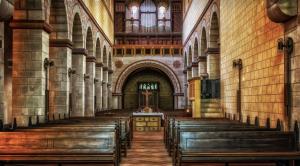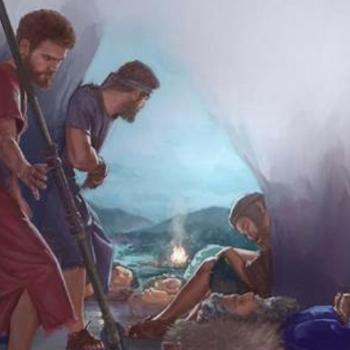A violent squall came up and waves were breaking over the boat, so that it was already filling up. Jesus was in the stern, asleep on a cushion. They woke him and said to him, “Teacher, do you not care that we are perishing?” (Mark 4:37–38).
When I hired at Catholic Answers in 2000, the staff met for prayer in a large multi-purpose room. The room was also used for meetings and for welcoming guest speakers. Seating was provided by office visitor chairs set up in rows. Most days we prayed either the rosary or the morning prayers for the day from Xeroxed copies of Magnificat. When we were fortunate to have a visiting priest, Mass was offered on a small, wooden table-style altar. We knelt on the floor.
For many years, even after Catholic Answers brought in a full-time chaplain and Mass was offered daily, the chapel remained utilitarian. Beneath the non-descript appearance though, care was taken to safeguard the Eucharist and to nourish the staff’s faith. When permission was granted by the bishop to repose the Blessed Sacrament, a locking tabernacle was installed. Staff brought in relics they owned to be kept on the altar during Mass.
During those years, I was a happy participant in the staff’s morning prayer. I took my turn making copies of morning prayer or leading the rosary. When we began to have daily Mass, I regularly volunteered as a lector. As someone who is nearsighted but hates wearing corrective lenses, I often sat near the front of the chapel so I could see without wearing my glasses.
Catholic Answers eventually decided to create a “real” chapel. The multi-purpose room would be transformed into space set aside for liturgical worship. The industrial carpet would be pulled up and new flooring put in its place. Pews would be installed. The walls would be re-painted and the interior decorated with stations of the cross and a Presence light near the tabernacle. Churchy hanging lights would take the place of fluorescent ceiling lights. The plain table altar was donated to a religious community that was downsizing its own chapel and a new altar would be installed.
A colleague who was on the planning committee reported to me that the committee had chosen to repaint the walls to look like marble—a soft white with gray and blue veins. To complement the marble effect, a section behind the altar (outlined by a faux stone arch) would be painted blue with white veins. Those plans were changed at the very last minute. Instead, at the direction of the apostolate’s president, the marble effect was replaced by a tarnished gold.
I remember walking into the chapel on the Monday after the walls had been painted. The floor was covered in terra cotta. The pews, complete with plush kneelers, were a warm, dark brown with glints of red. Against the gold walls, the new lighting was so overwhelming that the decision was made instantly to cut power to half the ceiling fixtures. The only relief from the “heat” was the sky blue paint under the arch. What was intended to mimic an Italian-style church interior looked for all the world like it was engulfed in fire and looking out on the promise of heaven. From the first moment I saw the completed renovation, I thought of that room as Chapel Purgatorio.
As Chapel Purgatorio took shape, my own interest in attending daily Mass at Catholic Answers foundered. Mainly, because someone who shall remain nameless started nitpicking my behavior at Mass. I didn’t stop attending right away, but over time it was made clear to me that everyone else had a better experience in the chapel when I wasn’t there, so I gradually stopped going.
A few examples: I started sitting in the back of the chapel because I was reprimanded for looking around during Mass. I wasn’t twisting in my seat to gawk at latecomers; rather, I tended to look around a bit during the liturgy and I was told that had to cease. Then I mostly stopped volunteering as a lector because He Who Shall Not Be Named told me it was inappropriate for me to lift my hand during the responsorial psalm. Never mind that this was a common gesture lectors use to indicate to the congregation when they should give the response.
The final straw was when he sat down in my office one day and told me that I hadn’t been picking up on his hints that I sang too loudly at Mass. I could ask anybody at the office and they’d agree with him, he said; my singing was a distraction to everyone. After that, I attended Mass rarely, usually on holy days. If needed, I’d occasionally lector (hands down). But I never again felt any desire to pray at Catholic Answers’ Masses, much less to sing.
No one noticed. Not once in all those years did the chaplains, my director, or any of my colleagues approach me and say, “Gee, Michelle, I never see you at Mass anymore. Is everything all right?”
When a storm hit the Sea of Galilee, “Jesus was in the stern, asleep on a cushion” (Mark 4:38). Christ’s disciples didn’t understand how he could sleep while waves hit the boat, which was starting to fill with water (v. 37). What they didn’t realize, at least in that moment, was that the stern is the most comfortable part of a boat and Jesus had a cushion under him. A man tired from a long day of preaching to crowds could easily fall into a deep sleep. If he’s in a sheltered, cushioned resting place, even a raging storm might not wake him.
In their fright, the disciples very likely shouted at Jesus to wake up. We do know they cried out to him, “Teacher, do you not care if we perish?” After calming the storm, Jesus asked them, “Why are you afraid? Have you no faith?” (v. 40). We often think of Jesus rebuking the disciples for not trusting they could just ride out the storm if they had sufficient faith. But perhaps Jesus was alluding to something else. The disciples had taken no notice of Jesus until they needed him. He was in the back of the boat, given a cushion, but nobody paid any attention to him. He might as well not have been there.
I was reminded of Catholic Answers’ chapel. In the early days, we all had to take part in cobbling together morning prayers. When a priest visited, we all had to work to make sure the multi-purpose room was ready for Mass. We didn’t have the luxury of a dedicated chapel, a full-time chaplain, and a tabernacle for Jesus to rest in between liturgies. We had to make do with what was available, and everyone’s participation (however imperfect) was needed and welcome.
With the rise of Chapel Purgatorio, however, no one noticed as a storm started raging. Jesus was there, resting in a golden tabernacle. He’d be brought out for daily Mass, placed carefully in a monstrance for weekly adoration, but if some of the disciples had been swept over the side of the boat and were sinking beneath the waves, oh well. At least the chapel looked pretty for visiting bishops and for streaming daily homilies on social media for Catholic Answers’ constituents.
Setting apart space to worship God in a dignified, beautiful setting is important. The Mass, Catholics believe, is the re-presentation of Christ’s sacrifice on Calvary, and participation in that liturgy is considered to be the source and summit of our faith. When we focus exclusively on the external trappings of the liturgy though—to such an extent that we’re not just evaluating the worthiness of the liturgical art and architecture, but are also evaluating the aesthetics of the worshippers—perhaps we’re giving Jesus a cushion and shoving him into the back of the boat.
Should it be any surprise then that some of the disciples may be swept overboard while Jesus sleeps in the stern on a pillow? Why should those who remain in the boat be afraid for themselves when they apparently had no need for Jesus to guide the ship, right up until it began to sink beneath them?
Michelle Arnold was a staff apologist for Catholic Answers, a Catholic apologetics apostolate in the Diocese of San Diego, California, from 2003–2020, answering questions from clients about the Catholic faith via phone, letter, email, and online platforms. She contributed essays to Catholic Answers’ online and print magazines, and wrote four booklets for the apostolate’s 20 Answers series. Her 20 Answers booklets were on Judaism, the New Age, witchcraft and the occult, and the Church’s liturgical year. Now a freelance writer, editor, and proofreader, Michelle Arnold has a blog at the Patheos Catholic channel. A portfolio of her published essays is available at Authory.













